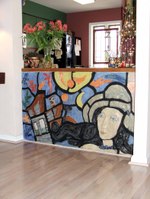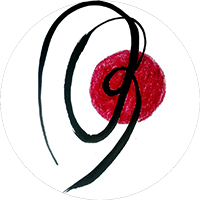 Hand-made architectural tile installation, Solstice, 3′ x 5′, by Tammy Vitale of Tams’ Originals
Hand-made architectural tile installation, Solstice, 3′ x 5′, by Tammy Vitale of Tams’ Originals
In July I blogged about Story and Social Change. Just to switch things up, and hit a bit on the "life" part of this blog’s title, I’m going back to the story theme.
When researching my thesis, I learned from Jack Zipes that there are 72 (I think that is the correct number) different versions of Little Red Riding Hood. Why might that be?
It is because, originally, "fairy tales" were used as teaching stories, and before the Grimm Brothers nailed a particular version immobile to the printed page, the stories evolved with the culture. Jack is packed away with many of my books for moving, but I still have a few books out. Here for food for thought is an excerpt from one.
"All of the original version of Red Riding Hood have got something about her choice of routes to her grandmother’s house; will she take the way of pins or the way of needles. This is omitted in our versions. They are also full of sexual reference. An interpretation that omits these elements is arbitrary. In the original versions the conversation between the wolf and the little girl is laced with racy innuendo: he asks her to get into bed with him, and she complies. Her surprised remarks on how she finds her grandmother’s body changed (‘How big…! How hairy…! How strong…!) and his lewdly double-edged answers are not at all the kind of talk that the nannies who use to reign in our nurseries would approve.
"When the wolf mets the girl (and the language suggests we should be imagining a girl approaching puberty), he asks her which way she is going to her grandmother’s house. Will she take the path of needles or the path of pins? Different versons put different answers into her mouth. The answer she gives does not matter. The important thing is the mention of the two paths. Peasant women in nineteenth-century France, when these stories were collected, had an informal system of age classes. The stages of a woman’s life were distinguished by the symbolism of pins and needles. Pins are easy to use but make only temporary fastenings; needles are employed with skill and perseverance, and make permanent ties. Putting a thread through the eye of a needle has a simple sexual connotation. Needles are for adult women, pins for courting girls who receive pins as gifts from their admirers or throw pins into the wishing well. The choice between pins and needles is in all the versions before Perrault and Grimm tidies them up to e suitable for our nurseries. Any interpretation that omits that detail is suspect." Mary Douglas, Children Consumed and Child Cannibals: Robertson Smith’s Attack on the Science of Mythology, Myth and Method, ed by Laurie L. Patton and Wendy Doniger
Thought for the day: We often read stories of all kinds enmeshed in our own lives. As shown by this entry, there are underlying symbols to many stories which we have lost and so lost much of the meaning of the story (or had it edited out for us by the Grimm Brothers, Walt Disney or the reigning moral arbiteurs of the day). The older a story is, the more chance it has been somehow manipulated over the course of its life. It gets harder yet when the story is "translated" from a different language (when subtle inferenes can be lost) or from "dead" languages (when we wouldn’t know even if we had the original text in front of us). Read everything that is held up as true and factual about history or anything else with a hint of skepticism. True and factual is only as good as the writer(s) who nailed it down.



1 Comment
[…] art pictures that has me about ready to tear my hair out (that would be LightRoom). So I needed a new story to pick me up and give me a bit of energy for the studio today since yesterday I slept a lot and […]